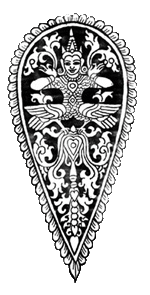 |

|
|
HINDU SURAS
While not specifically referred to as
angels, Hinduism does have many
different types of spirit beings who act
in a similar capacity. One example is
the minor gods, or devas, literally
"shining ones," who inhabit the higher
astral plane. Gods, devas, planets like
Sani (Saturn), gurus (teachers), and
ancestors can all play a protective role
for humans. Hindu traditions derived
from Indo-Aryan tenets, consider Suras (or Devas) to be
beings of light, gods of various kinds, while Asuras ('not
Suras') are darker beings, evil spirits or demons, largely
with dark instincts and are most commonly portrayed as the
embodiments of evil ( for instance demon king Ravana). As
the celestial forces of light, the Suras are ever in
opposition to the Asuras, those who are literally "without
light. The earliest myths speak of the Suras and Asuras as
brothers with the same father and different mothers. In
Zoroastrianism, the opposite linguistic paradigm holds true
- Ahura is the being of light, all powerful and all
good, while Daevas are the embodiments of evil. The
name Sura is believed to derive from the Proto-Indo-European
deiwos, originally an adjective meaning "celestial"
or "shining".
The Asuras are fallen devas who inhabit the lower astral
plane, the mental plane of existence. If asuras do good,
they can be reincarnated into devas and do not have to
remain eternally in the lower plane. Hinduism also includes
apsaras, who are heavenly nymphs, angiris, who preside over
sacrifices, and lipika, who regulate karma. |

WORLD RELIGIONS
COMPARED
WORLD
RELIGIONS CLIPART
WORLD
RELIGIONS HOME
HINDUISM HOME
HINDU SPIRIT WORLD |
Devas and apsaras are spiritual beings, but they are often
depicted in physical form. Apsaras are seductively beautiful
and the devas often look like royalty, stately and handsome.
 |
APSARAS: Female
spirits of nature. They are usually water nymphs or
forest spirits. Apsuras are considered very talented
artistically, and all of them are described as being
very beautiful. They love to dance and they often
performed for gods.
|
|
|
DEVAS (DEVATAS / ANGELS): The Hindu scriptures speak about
many celestial entities, called Devas
("The shining ones", also called devatās).
The word Devas may be translated into
English as gods, demigods, deities,
celestial spirits or angels. The
feminine of deva is devī.
|
|
|
DHANAVA:
|
 |
GANDHARVAS: Were male
fairies that were seen as heavenly musicians. Some are
depicted with human head and the body of horses, called Kinnaras and resembled the Greek centaurs.
Oftentimes they were represented as half man, half bird.
|
|
|
GARUDA (DEVOURERS): The king of birds, with golden wings,
living below heaven but above the highest trees of the
earth. The Garudas are associated with the legends of
the Roc and the Phoenix, and they are said to be able to
travel a hundred thousand miles in a single day. They
are the enemies and devourers of serpents (Nagas). They
are called 'The Wings of Speech', and they represent the
spiritual power and magic of the spoken word, which
conquers nature, invokes and inspires the mind and
carries it far and wide. The god of knowledge (Vishnu)
is said to ride on the Garuda's back and the Garuda is
said to carry the 'Wish-Fulfilling (Cintamani) Gem'
around its neck.
|
 |
KINNARAS: In Hindu
mythology, a kinnara is a celestial musician, half-human
and half-bird.
|
|
|
LIPIKA: Regulate Karma.
|
|
|
MAHADEVAS: The landscape, the divine forest, and the the
sacred rivers were enlivened and hallowed by the
presence of the Nature Spirits. The elemental beings of
air, water, fire, and earth enlivened and sanctified
Hindu daily living.
|
|
|
MITHUNAS: These are celestial couples who are a
common motif across temples both buddhist and hindu.
They are believed to exert an influence which is both
auspicious and magically protective.
|
|
|
RISHIS / SIDDHAS: Attained holy status because they were
ascetics and composers of the hymns of the Vedas.
Some of the famous Rishis are Vashishta, Vishvamitra,
Brhaspati, Kashyapa, Agastya and Narada, the inventor of the
musical instrument veena.
|
|
|
SHALABHANJIKAS: Fertility goddesses often depicted against
trees with one leg bent up and one hand holding a
branch. They are believed to be virgins who were capable
of making a tree bear flower.
|
|
|
VIDHVADHARAS: Heavenly magicians, residing in the
Himalayan magic cities, able to transform themselves at
will and also fly through the air. They are wisdom
bearers. always seen with a small garland, who fly above
the heads of gods. The garland symbolizes the attainment
of supreme (spiritual) wisdom.
|
 |
YAKSHAS: Creatures often with dual
personalities, found in Hindu and Buddhist mythology. On
the one hand, a Yaksha may be an inoffensive
nature-fairy, associated with woods and mountains; but
there is a much darker version of the Yaksha, which is a
kind of cannibalistic ogre, ghost or demon that haunts
the wilderness and waylays and devours travelers.
|
The eighteen Ganas as
per Hindu cosmology are:
Devas, Siddhas, Asuras, Daityas, Garudas, Kinnaras, Nirutas,
Kimpurushas, Gandharvas, Yakshas, Vinjayas, Bhutas, Pisachas,
Antharas, Munivas, Uragas, Akashavasis and Bhoga Bumidars.
Whoever knows all his past
lives,
Sees both the happy and unhappy realms,
Who has reached the end of births,
Who has achieved perfect Insight,
And has attained the summit of the holy life.
Him do I call a Noble One.
Buddha, The Dhammapada

| |
 |
 |

